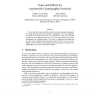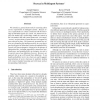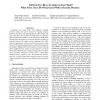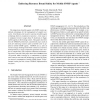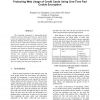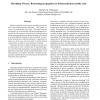CSFW
2002
IEEE
15 years 5 months ago
2002
IEEE
We present the first type and effect system for proving authenticity properties of security protocols based on asymmetric cryptography. The most significant new features of our ...
138
click to vote
CSFW
2002
IEEE
15 years 5 months ago
2002
IEEE
We carry forward the work described in our previous papers [3, 14, 12] on the application of data independence to the model checking of cryptographic protocols using CSP [13] and ...
98
Voted
CSFW
2002
IEEE
15 years 5 months ago
2002
IEEE
We study a security property for processes in dynamic contexts, i.e., contexts that can be reconfigured at runtime. The security property that we propose in this paper, named Per...
CSFW
2002
IEEE
15 years 5 months ago
2002
IEEE
Important properties of many protocols are liveness or availability, i.e., that something good happens now and then. In asynchronous scenarios these properties obviously depend on...
89
Voted
CSFW
2002
IEEE
15 years 5 months ago
2002
IEEE
We introduce a general framework for reasoning about secrecy requirements in multiagent systems. Because secrecy requirements are closely connected with the knowledge of individua...
108
Voted
ACSAC
2002
IEEE
15 years 5 months ago
2002
IEEE
Designers are often faced with difficult tradeoffs between easing the user's burden by making security decisions for them and offering features that ensure that users can mak...
90
Voted
ACSAC
2002
IEEE
15 years 5 months ago
2002
IEEE
The integration of mobile agents with SNMP creates significant advantages for the management of complex networks. Nevertheless, the security concerns of mobile agent technology l...
ACSAC
2002
IEEE
15 years 5 months ago
2002
IEEE
The blooming e-commerce is demanding better methods to protect online users' privacy, especially the credit card information that is widely used in online shopping. Holding a...
93
Voted
ACSAC
2002
IEEE
15 years 5 months ago
2002
IEEE
Modern computer viruses spread incredibly quickly, far faster than human-mediated responses. This greatly increases the damage that they cause. This paper presents an approach to ...
109
Voted
ACSAC
2002
IEEE
15 years 5 months ago
2002
IEEE
In this paper we present PEAT: The Portable Executable Analysis Toolkit. It is a software prototype designed to provide a selection of tools that an analyst may use in order to ex...
